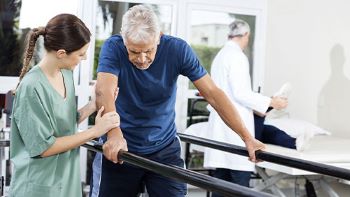New expert review of the global approach to rehabilitation following fragility fracture

Fragility fractures, which affect an estimated one in three women and one in five men over the age of 50 years worldwide, are a major cause of disability and loss of independence. After a patient sustains a fragility fracture, rehabilitation is a critical component of the treatment pathway, allowing patients to regain functional capacity and mobility.
A new publication by the International Osteoporosis Foundation (IOF) Rehabilitation Working Group summarizes the global state of the evidence for the rehabilitation of patients post-fragility fracture without cognitive impairment and points to directions for future research.
Corresponding author and Working Group Co-chair, Assistant Professor Daniel Pinto, stated:
“Rehabilitation interventions result in considerable improvements for patients, and the benefits can be realized up to a year after fracture. However, rehabilitation modalities are both complex and inter-reliant, involving the interaction of exercise, nutrition, physiotherapy, falls prevention programs, and patient education, among other modalities. In this narrative review, we looked at distinct elements of a comprehensive approach to post-fracture management and analyzed the state of the evidence for each. The aim was to provide a succinct resource for clinicians and for Fracture Liaison Services, which are important providers of multidisciplinary post-fracture care.”
The review analyzed scientific literature and clinical studies conducted from 2010 and 2020, concluding that:
- Multi-modal exercise post fragility fracture to the spine and hip is strongly recommended to reduce pain, improve physical function, and improve quality of life;
- Outpatient physiotherapy post-hip fracture has a stronger evidence base than outpatient physiotherapy post vertebral fracture;
- Appropriate nutritional care after fragility fracture provides a large range of improvement in morbidity and reduces mortality;
- Patient Education increases understanding of osteoporosis and in turn, increases utilization of other rehabilitation services. Education may also improve other health outcomes such as pain and increase a patient’s ability for self-advocacy.
Professor Olivier Bruyère, senior author and Working Group Co-Chair stated:
“We know that the various post-fracture rehabilitation interventions which have been outlined in this review act independently or interdependently to build functional capacity and decrease the risk of future falls and fractures. However, there is a clear need for further research to reinforce the evidence base for a comprehensive global approach to rehabilitation.”
The review highlights seven distinct recommendations for future research. These include: the development of individualized exercise approaches considering patient preferences and adherence; defining exercise regimens that reduce kyphosis and pain after vertebral fracture; defining exercise regimes which ensure the best recovery and the shortest length of stay in rehabilitation units; better understanding of patients’ and caregivers’ educational needs; rehabilitation strategies across the continuum of care, including the characterization of rehabilitation dosage and transition between rehabilitation settings; the relationship between malnutrition and fracture healing, rehabilitation and future fracture risk; and, rehabilitation strategies associated with Fracture Liaison Services for secondary fracture prevention.
Professor Nicholas Harvey, Chair of the IOF Committee of Scientific Advisors, added:
“We thank the IOF Rehabilitation Working Group for this important review, which offers clinicians, and in particular Fracture Liaison Services, an important resource to support patients on the pathway to recovery and prevention of further fractures.”
###
Reference:
Pinto, D., Alshahrani, M., Chapurlat, R. et al. The global approach to rehabilitation following an osteoporotic fragility fracture: A review of the rehabilitation working group of the International Osteoporosis Foundation (IOF) Committee of Scientific Advisors. Osteoporos Int (2022). https://doi.org/10.1007/s00198-021-06240-7